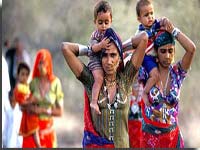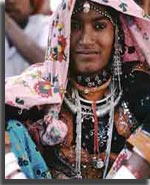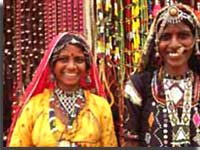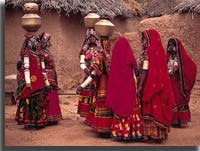History :
The word Bhil is derived from the Bil or Vil which mean Bow. They are the largest tribe of South Asia and constitute 39% of the total population of Rajasthan. Bhils are known as bow men of Rajasthan or the tribals of Mewar or the Archers. Bhil tribe is divided into two groups, the Central or Pure Bhils found in the mountains ranges of Madhya Pradesh, Maharashtra, Gujarat, Rajasthan and Eastern Rajput Bhils are found in eastern parts of Tripura. These tribes have been mentioned in epics like Mahabharata and Ramayana.
Indian Mythology says that Bhil women offered ber or jujube fruits to Lord Rama, when he was in the jungles of Dhandaka, searching Sita. In the history of independent India these tribes of India were regarded as the fighters who were in a war against the Mughals, Marathas and the Britishers. Bhils furnished the needs of Princes of Mewar with bowmen, supplies or by guarding their families. Some names of Bhils are Bhim, Bhim Singh Maharana, Bhimisi and Bhindar who were very famous. They were employed by the Rajputs as Shikaris and as Warriors in colonial times. Mewar Bhil Corps today is the acclaimed Corps of Mewar. They are the best archers and also excellent in geographical knowledge and third largest tribe in India after the Gonds and Santhals.
Culture
Bhils religious practice differs from place to place. They worship local deities like Khandoba, Kanhoba, Bahiroba, and Sitalmata. They worship Tiger God called 'vaghdev'. Bhils don't have temples of their own and consult Badvas -the hereditary sorcerers on all the occasions as they are highly superstitious tribal people.

Dance and music are given importance by Bhils due to their rich cultural history. The famous dance among the Bhils is Ghoomar and Gair which is the religious dance drama performed by the men in the month of Sharavana (July and August). The Bhil Tribes are talented in sculpture work and make beautiful horses, elephants, tigers, deities out of clay.
Place /Location (then and now) |
Rajasthan, Madhya Pradesh, Gujarat |
Population |
2505888 |
Languages spoken |
Bhili |
Religion/God |
Tiger God Called "vaghdev"a |
Food |
Maize, Wheat and Fruits |
People

Food
The main food of the Bhils is Maize. Wheat is used on special occassions and hospitality. KURA, KODRA, BATTI, SANGLI, KORANG etc. are used as food. Roti of Maize also called SOGRA with CHATNI, GREEN CHILLI or Stitle and Curd Lassi is the famous food. Fruits also are the part of their diet.
Languages
The Indo Aryan language called Bhili is the prime language spoken by Bhils tribes of India.
Occupation
The source of the income for Bhil is Agriculture and the Animal Husbandry. Poultry farming and labour also form the source of income. Bhils posses knowledge of manufacturing agricultural equipments and are also aware of repairing them.
Society Pattern

They follow Polygamy. A Bhil woman is open to marry a man of her choice even after her marriage. They follow Paternal Family System' system in which the family considers the joint family as the major force of life. The women, sons and daughters are free to lead their own lives and there is a tradition of adapting children in this society.
Festivals

At night all of them enjoy Raslila at the Lakshmi Narayan temple. Cultural shows, magic shows, animal shows, acrobatic feats are the main attraction of the fair. This fair is actually the combination of two fairs, which are held in reverence of Lord Shiva and the other one that commenced after the setting up of Vishnu temple by Jankunwari. Holy and Dusshera are the other major festivals celebrated among the Bhils in India.


